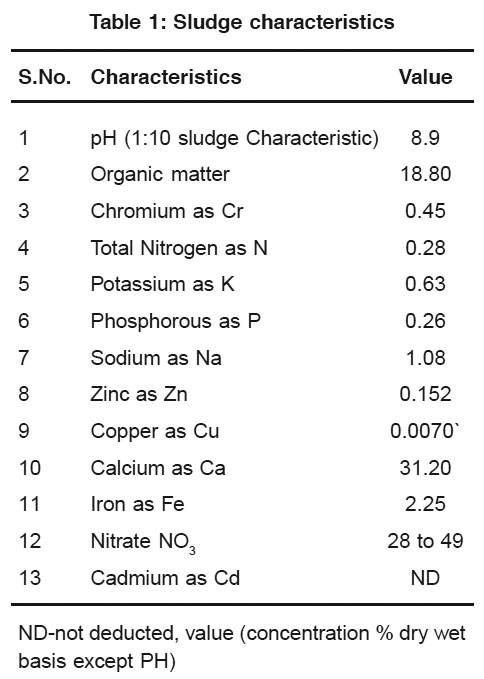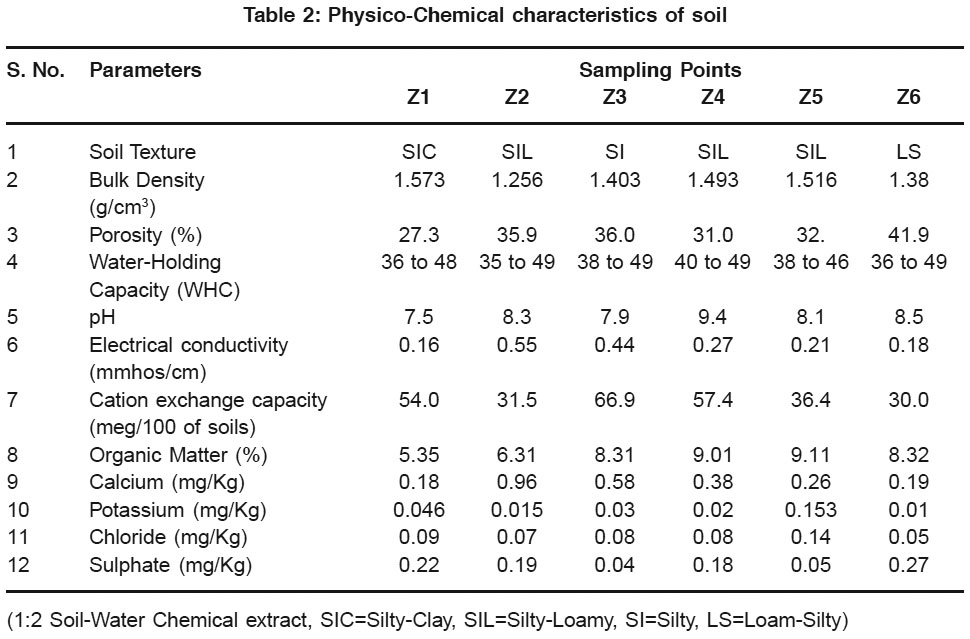Impact assessment of chemical fertilizer industry on quality of soil in and around Vijaipur, district Guna, M.P. (India)
R.P. PRAJAPATI1 * , ANAND SHARMA2 and D.R. TIWARI3
1
Department of Chemistry,
Regional Institute of Education,
Bhopal,
462 013
India
2
Department of Chemistry,
MVM,
Bhopal,
462 001
India
3
Department of Geology,
MVM,
Bhopal,
462 001
India
DOI: http://dx.doi.org/10.12944/CWE.4.2.28
A study was carried out on the impact of Chemical Fertilizer Industrial waste on the quality of soil in the vicinity. The Fertilizer Industry located at Jijaipur District Guna (M.P.) India, produce liquid ammonia and urea. All the solid waste generated are disposed off at dumpsites (Surrounding Fertilizer Plant). Teh effluent sludge and Soil sample were analysized for physio-chemical parameters viz pH values, Phosphrous, Sodium, Chromium, bulkdensity, porosity, water-holding capacity, electric conductivity, organic matter and Cation exchange capacity of soil using standard methods. The results revealed that the dumpsite sludge sample recorded very high concentration of Potassium and Calcium. The effluent samples from the outside showed lower value of Potassium and Calcium. The Soil environment around the dumpsite was the most affected the highest mean value of potash and phosphorous respectively.
Copy the following to cite this article:
Prajapati R.P, Sharma A, Tiwari D.R. Impact assessment of chemical fertilizer industry on quality of soil in and around Vijaipur, district Guna, M.P. (India). Curr World Environ 2009;4(2):429-432 DOI:http://dx.doi.org/10.12944/CWE.4.2.28
Copy the following to cite this URL:
Prajapati R.P, Sharma A, Tiwari D.R. Impact assessment of chemical fertilizer industry on quality of soil in and around Vijaipur, district Guna, M.P. (India). Curr World Environ 2009;4(2):429-432. Available from: http://www.cwejournal.org/?p=1010
Download article (pdf)
Citation Manager
Publish History
Select type of program for download
| Endnote EndNote format (Mac & Win) | |
| Reference Manager Ris format (Win only) | |
| Procite Ris format (Win only) | |
| Medlars Format | |
| RefWorks Format RefWorks format (Mac & Win) | |
| BibTex Format BibTex format (Mac & Win) |
Article Publishing History
| Received: | 2009-08-02 |
|---|---|
| Accepted: | 2009-09-11 |
Introduction
Vijaipur Fertilizer Plant is located at Vijaipur village in Radhogarh Tehsil of Guna District (M.P.) India. The Fertilizer Plant Constracted by NFL- comprises of one 1350 TPD single stream ammonia plant based on stream reformation of natural gas and 2200 TPD Urea Plant consisting of two streams each of 1100 TPD capacity. It utilized as combination of natural gas naphtha, fuel oil and filler sand at varying condition for the production of different formulation of fertilizer products viz liquid ammonia and urea. Each production process result in the release of large quantity of nitrogenous and phosphorous containing wastes into receiving aquatic and terrestrial ecosystems. The attendant ecological problems associated with these discharges especially on the soil ecosystem has been under taking in this study. Generally soil compr ises physical, chemical and biological substances which show alternation due to impact of various environmental factors and industrial contamination wastes.
The study of physico-chemical characteristics of soil were carried out by several workers, Sahai et.a. (1979) Sahai and Shrivastava (1988), Agrawal S. K. and Gupta H. (1992) and Kadeyarona (1989), Ahemed et. al (1996), Achrajee et. al. (1999). The main objective of this study is to assess the impact of the fertilizer effluent and other fertilizer wastes products on the quality of the receiving terrestrial eco-system as its effects cultivation and plantation in the host community.
Study Area
This study was conducted primarily in one premises of Nitrogenous Chemical Fer tilizer Industry at Vijaipur, District Guna (M.P.) India. The area of study is about 25 kms from the Guna town. Nearest railway station Reethiyai which is about 6 kms from the complex. Ruthiyai junction falls midway between kota (North-West) and Bina (East). Delhi- Agra-Bombay National highway (NH-3) its 4 kms away on the eastern side the complex at the Vijaipur Fertilizer Plant. River Parvati flows on the western side of the plant, at a distance of about 4 km. Chopan river flows on Northern side, about 2 km always from the plant and ultimately joins river Parvati. Both rivers are main water receiving body for industrial effluents.
The area of study lying between latitude 77° to 77o15' longitudes to 24°15' to 24°40'. The geology of area of study presents a specific hydrogeological pattern. The top 0.5 to 1.0 m consists of black cotton followed by 3.0 m thick black basalt rock and down up to 60 m, it is hard rock. The selected area has an elevation of 421 m above mean sea level and the climatic conditions is semi- arid. The mean annual rainfall varies from 531 mm to 1972 mm. There is fairly high variability in reainfall from year to year and the probability of receiving mean annual rainfall varies from 40-50%. The maximum temperature goes up to 45°C while the minimum recorded is as low as 2°C.
Materials and Methods
Soil samples at a depth of 04 to 16 m of the top soil were collected cross sectionally using an auger from 6 major location along with sludge around the dumpsite of fertilizer plant. The study was conducted for period of one year (June, 2008 to May, 2009). The sample location are about 5 km apart from plant site and the soil of these location were silty, clay and loamy. Soil sample were analyzed for physical and chemical characteristics. In each case the soil sample of totaling six location were subjected to pretreatment which included air dried, cleaned, crushed and passed through 2mm mesh sieves and analyzed in laboratory (1:2 soil- water extract) using standard method. The chemical parameters determined were inorganic compound such as Kjedahl Nitrogen (N), Calcium and metal such as Na, K, Fe, Zn, Ni, Cr etc. The determination of total Nitrogen was done using total (Kjeldahl) Nitrogen method whereas Phosphorous determination was done spectro-photometerically using molybdovanadate method, the sodium and potassium were estimated directly in the extract using flame photometer, whereas Ca wa s determined EDTA titration and other metals were determined using AAS. pH value was measured by method described by Anderson and Ingran (1989) using a standard pH meter. Similarly the conductivity measurement were made by a standard conductivity meter. The results are expressed in mg/L as well as in g/100g(%).
 |
Table 1: Sludge characteristics Click here to view table |
 |
Table 2: Physico-Chemical characteristics of soil Click here to view table |
Results and Discussions
The result of the present study is presented in Table 1 and Table 2. The result of sludge characteristic value is given in Table 1. It indicate high value of pH, organic matter, potassium, chromium content and also other metals.Similarly the result of the sampling station of outside of plant about 5 km apart from plant about 5 km apart from plant side are given in table-2. The soil in the region normally alkaline (pH 7.5 to 9.4) in nature with high porosity, high cation, exchange capacity and somewhere water holding capacity are very low. At some places the soil is silty-loamy to silty-clay and rarely loamy.
Conclusion
The present study has indicated that the quality of soil especially around the Industrial premise was affected by high levels of Phosphorous, Nitrogen and Potash when compared to soil sample location the vicinity of the plant although impact of the pollutants assessed appeared to be more on the soil, there may be risk for ground water quality in the vicinity. The overall implication of this study call for the management of the fertilizer complex to check there waste management practices so as to circumvent the discharge of its pollutants in to surrounding eco-systems that may pose associated health risks and hazards.
References
- Anderson, J. M. and Ingram, J.S.I. Tropical Soil Biology and Fertility : A Hand Book of methods. CAB International U. K.;(1989) 1-1000.
- Saxena, S. K. Mehara, Kand Ali, A. Environmental Implication of Nitrogenous Fertilizer Industries in India. In Environmental Implication of Nitrogenous Fe r tilizer Industries in India. In Environmental Risk Assessment. Eds. Y.N. Sahai, P. B. Deshmukha, T. A. Mathai and K. S. Pillai. The Academy of Environmental Chemistr y, Muzaffernagar,(1989) PP 180-186.
- Pakal Y.R. Fertilizer Chemical Industry in pollution control hand book. Ed. PL. Diwakar, Utility Publication Secunderabad.(1986) P. P. 332-341.
- Pollutants Wastes and by - Products of the Fer tilizer Industr y, Neculai N. Popovici Chemenco Ltd. Bucharest Romania.
- Welcher, F. J. "Standard Methods of Chemical Analysis" Sixth Edition, Vol. 3(B), D, Van Nostrand Company Inc, New York (1966).
- USEPA "Testing Methods for Evaluation Solid Waste", SE - 846 Third Edition (1986).
- Marion, G. M., Kummerow J. and Millir, P.C. Predicting nitrogen mineralization in chaparral soil, Soil Sc. Soc. Am. J.,(1981) 45: 956-961.
- Pandit, B. R., Patel, D. and Pandya, U. The Physico-chemical Proper ties of Soil of Jessore sloth Bear Sanctuary, Gujarat. Nature environment and pollution technology,(2004) 3(4): 553-556.
- Mahabubani, A. K. Treatment of nitrogenous Fertilizers Industries waste by activated algae method in Proc. Symp. Environmental Conservation, IEO, Kota.(1980) PP 1-15.
- Cottenie, A. Chemical Fertilizers in Relation toAgr icultural Production. Medelingen Fakulteit land bowviretens chappengent (1973) 38(4): 1722-1731.
- Muthutha, A. S. Zaranyiks, F. M. and Jonnalajadda, S.B. Effect of discharge from a fertilizer plant an upper Mukunisi river environment internation,(1993) 19: 51-61.
- Agrawal S. K. and Gupta H. Effect of Nitrogenous Fertilizer Factory effluent on Seedling Groth and Bio-Chemical Characteristics of Brassica Compestries and Cicer ar ietinu s. Acta Ecological,(1992) 14: 1:53:53.60.
- Jackson, M. L. Soil Chemical Analysis, Prentice Hall of India Ltd., New Delhi (1967).






